You know that advertising phrase “new and improved?” It is one of those pieces of fluff text that bugs the heck out of me. If the thing we are discussing is new, then it has not been improved upon because there is nothing that came before to which it should be compared. If the thing we are discussing is improved, then it is not new because the implication is that this was a modified version of something that did come before.
I believe I have found the item that finally makes that mumbo-jumbo make sense. Trekking the World (Second Edition) is a new and improved version of Trekking the World!
Before we get too deep into the comparisons, though, let’s look at how Trekking the World (Second Edition) plays. If you’re already familiar with the game, skip on down to my thoughts at the end of this review.
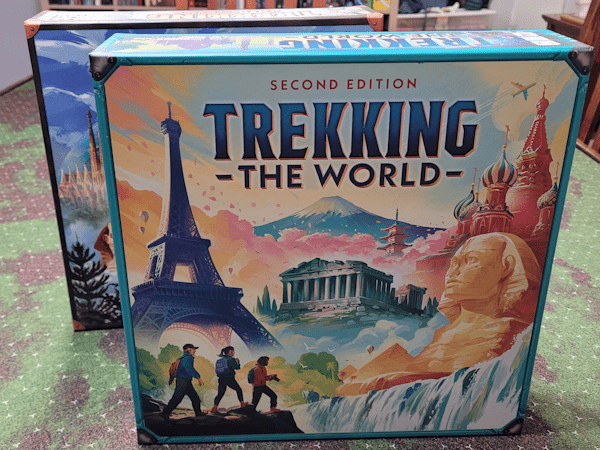
Overview
In this game, you are a traveler (called a trekker in the rules, but that term reminds me too much of the more serious side of Star Trek fandom, so I am not going to use that term in this review). Your traveler starts on one of the airport spaces on the board (one per continent).
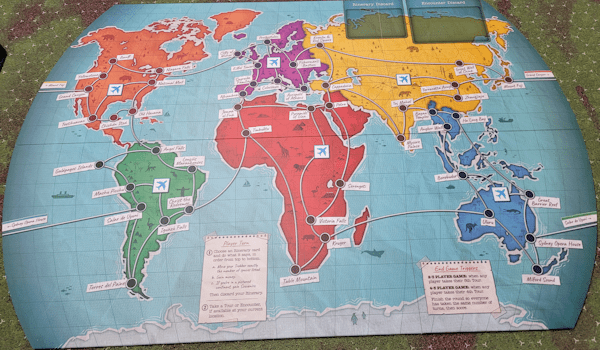
Along with their traveler meeple, players receive a money counter (a coin that will show a money value between $0 and $20), a player board (called their suitcase, used for collecting their souvenirs), and a frequent flier token (more on that later). The youngest player receives the first player marker.
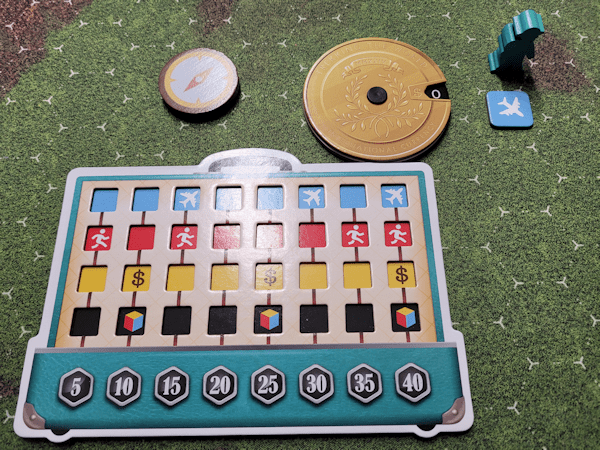
At one side of the board, the destination deck is shuffled then split into two roughly equal halves with one half showing the destinations that can be used as tours, and one half showing the destinations that can be used as an encounter. Each of these decks has four options at any given time. Near this, the itinerary deck is shuffled and set up so that five cards are always available.
On a player’s turn, they may select any one of the available itinerary cards. Each has a set of three actions the player takes in order: movement, money, and souvenirs.
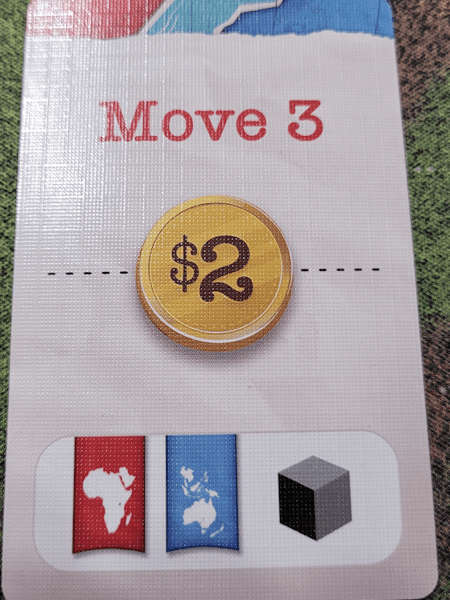
For example, if a player selected this itinerary card, they would move exactly 3 spaces on the board (no hitting any space twice, including the space the player started on), then add +$2 to their money tracker, then collect a black souvenir cube for their player board—if their traveler ended their movement on either the continent of Africa or Australia.
When moving, players can pass through Airports like any other space. However, if they want to spend $1, they can move from an airport to any other airport on the board. Players cannot amass more than $20 at any time. And as they play their souvenir cubes, they will gain itinerary tokens (see below).
Itineraries are not all created equal. The combination of movement and money can sum to anywhere from 2 to 5. The collection of the souvenir cubes may be restricted to a single continent, or two; the card may indicate the player gets one cube or two. In general, if the movement is higher, the coins are lower; if the card has two continents, then it is one souvenir cube; otherwise it might be two.
As players collect souvenirs, they will cover special spaces on their player board that grant them itinerary tokens. These give them special one-use powers as well.

- A player may, prior to selecting their itinerary card, play a frequent flower token (blue). When played, this token moves them from wherever they are on the board to any airport space instantly. They then select their itinerary card and begin their movement from this location.
- A player may, after selecting their itinerary card, spend any number of their movement tokens (red) to increase their movement that turn by +1 each.
- A player may, after selecting their itinerary card, spend any number of their money tokens (yellow) to increase the amount of money gained by the printed value on the card for each money token spent.
- A player may, after selecting their itinerary card, spend any number of their souvenir tokens (black) to increase the number of souvenirs they gain by the same number and type printed on the card for each souvenir token spent.
Spending a token puts it back in the supply. Some of these are rather tough to come by, so deciding when to spend them is critical.
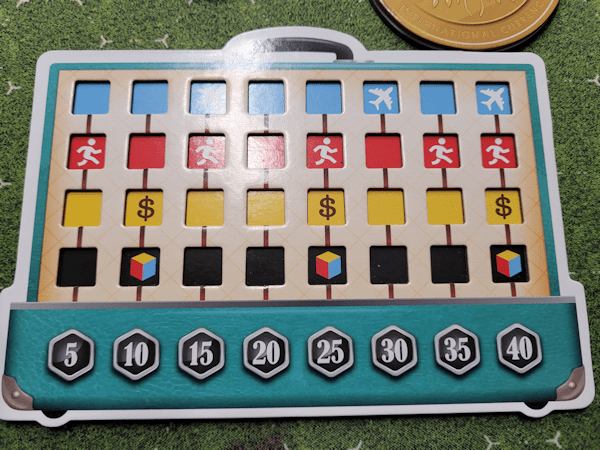
After the player has completed their itinerary, they check the display of four locations where a tour or an encounter can take place.
- If the player’s traveler ended its movement on a location where they can take a tour, and they have the money needed to take that tour, they can pay that amount and claim the tour. They will receive the points for that tour at the end of the game.
- If the player’s traveler ends its movement on a location where they can have an encounter, they claim the encounter (it costs no coins), and place it in their playing area. On any later turn, they can spend the encounter card for the special one-time ability listed on it. Some encounter abilities start with the phrase “At game’s end’; these encounters are not played during the game but instead provide bonus points if the player can meet the requirements. The special powers are interesting! They often require you to spend some of your souvenirs, meaning that the tracks can go up and down (and recovering a space will get you another token).

Once a player has collected enough tours (varies depending upon player count, and the player’s desire for length of game), play will continue until all players have had the same number of turns.
At the end of the game, the score for each player is the sum of:
- The value of each tour they purchased.
- The value of any “At game’s end” encountered they collected.
- The value of the souvenirs in their suitcase.
That last one is based on the number of complete sets of souvenirs they have collected. For example, this suitcase scores 10 points. Although the player has more blue souvenirs, they are missing the necessary black souvenir to get 15 points, a red and black to get 20 points, and so on.

The player with the most points wins.
Thoughts
New
I like Trekking the World (First Edition).I enjoy it a lot. But this is not so much a new edition as it is a new game. So many of the mechanics, as well as the game play and the basic feel of the game are distinct from the original.
This is a good thing. And a bad thing.
- I liked the two timers on the original game (number of tours taken, and number of souvenirs available on the game board).
- I liked that the souvenirs were specific things (e.g., postcards, statuettes, clothing, and crafts). Now they are just called blue, red, yellow, and black.
- I liked the special bonus cards for having the most of a certain souvenir. Given that these can fluctuate up and down now, might mean such a thing is not workable.
- I liked the continental bonus for taking the final souvenir, and the bonuses for the most recent tours that became available. Under the current rules, this would not work at all.
- I liked the bonus actions that could be taken and the fact that they were different in each game. This is not practical given the way the itinerary cards work.
All of these result in a feeling that something was lost in translation. A lot changed, enough so that this is not the same game! Not by a long shot.

Improved
There are things about the first edition that bugged me. Given the shift in game type, those issues are no longer issues.
- I disliked the fact that you were forced to interrupt the set collection aspect of the game because you had to spend at least one of your cards on movement every single turn.
- I disliked the fact that you could spend a half-dozen turns trying to get the one Adventure card (or whichever card you did not have and never came into the market) that you needed to claim a tour. Meanwhile your opponent has managed to take it the same turn that you finally had one available.
Not having these in the game is a definite improvement. But to be honest, other than these two small things, I really like the first edition.
And in the end, I really like the second edition, too.
Now How Much Would You Pay?
There is something that was introduced with the new rules that, while not wrong, feels odd. The destination deck is split in half such that half the locations are available as tours and half are available as encounters. There is a good chance you are going to empty the encounter deck. When you do, you are told to shuffle the discards into a new pile. Fine.
What feels off here is that the same locations you have already visited for encounters are going to come back up again. Players will be revisiting their old haunts. When this happened mid-game, my friend Rich suggested an alternative: when the encounter deck is emptied, flip the tours deck over and shuffle up the encounter discards as a new tour deck. I cannot think of any issues this would cause.
Of course, you could keep the deck as a single whole, and deal off a card from it to go into whichever spot becomes available. I suppose that would work as well.
Final Thoughts
If you did an accounting of the things I have listed above, you might come to the conclusion that I think the first edition is the better game. And this would not be the case. The first edition is a different game, not a better one.
Trekking the World (First Edition) is a family weight, set-collection game about visiting various tourist spots around the globe. Trekking the World (Second Edition) is a light weight strategic puzzle game about visiting various tourist spots around the globe. What this means is that I will be keeping both games in my collection because, despite the almost identical theme and game board, these two games serve different purposes. They are very different experiences.
If I want to play a game with my less hobby-centric friends where we can have fun while carrying on several side conversations, I will pull out the OG. If I want to play a game with my more hobby-centric friends where we work to maximize the impact of each turn in an effort to reign supreme at the gaming table, the new kid is coming off the shelf.


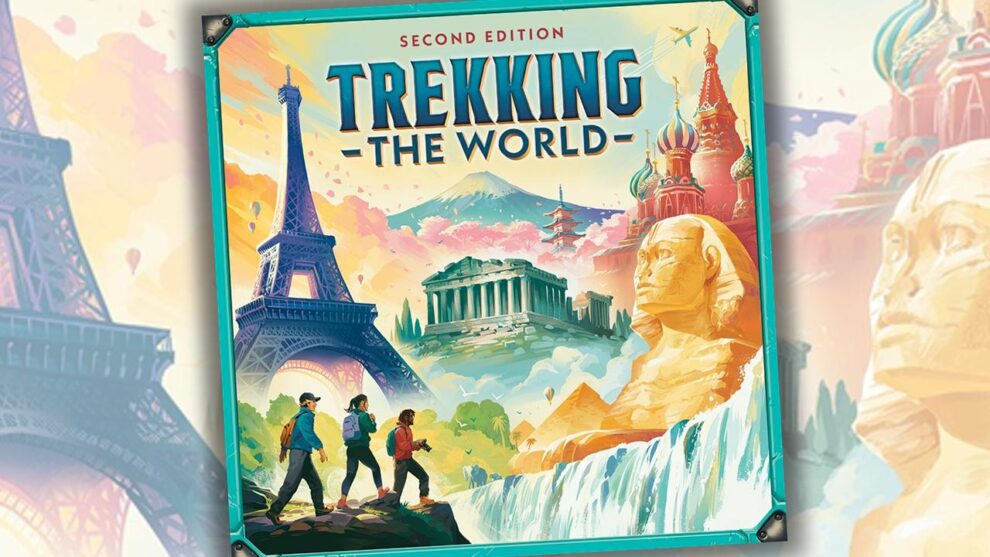









Add Comment